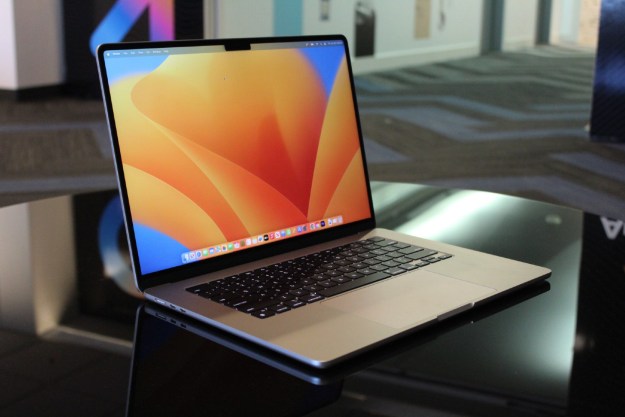
Picking out a new MacBook isn’t as easy as it used to be. If you’ve already ruled out the smaller 13-inch MacBooks on account of preferring a larger screen or more performance, you might be left considering two compelling options: the 15-inch MacBook Air and the 14-inch MacBook Pro.
Having reviewed and used both laptops extensively, though, I’m here to lay it all out for you. Here’s the difference between the two machines and how to easily determine which is right for you.
The easy way to know which to buy
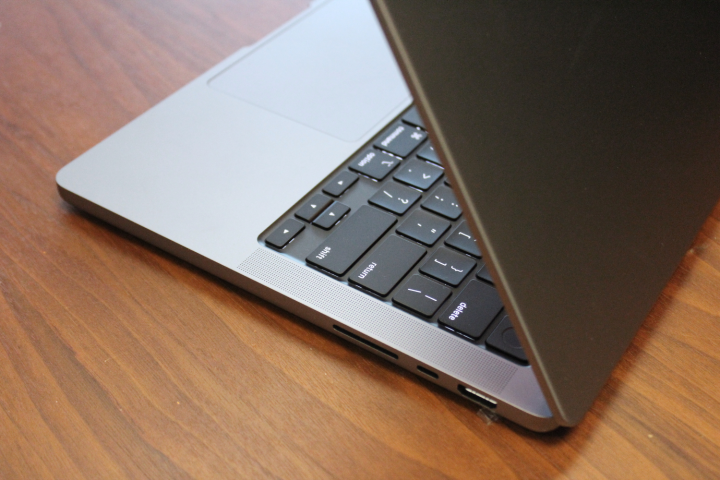
I promised you an easy way to know which MacBook you should buy, and it really comes down to answering just one question: what do you want to do with your new MacBook? If you’re someone who spends more than half your day in front of Premiere, Final Cut, Pro Tools, or Lightroom, don’t mess around with the 15-inch MacBook Air. It’s fanless, and it just can’t power through tasks as fast as you’ll want it to.
However, if you like to use some of those applications on occasion but spend the majority of your time in a browser or in Word — the 15-inch MacBook Air is the better option. It’s cheaper, thinner, and lighter, without sacrificing things like a quality display, speakers, webcam, and keyboard.
My only caveat is that if you’re someone who requires connecting two or more displays to your MacBook, the 15-inch MacBook Air likely isn’t a good option. It only supports one external monitor natively, and though you can get around that limitation, it’ll require some finagling.
If you don’t have a clear-cut answer from that alone, dive into the detailed comparison below for more hands-on information from our own testing.
Specs and configurations
| Apple MacBook Air 15 | Apple MacBook Pro 14 | |
| Dimensions | 13.40 inches x 9.35 inches by 0.45 inches | 12.31 inches x 8.71 inches x 0.60 inches |
| Weight | 3.3 pounds | 3.5 pounds |
| Processor | Apple M2 (8 cores) | Apple M2 Pro (10-core, 12-core) Apple M2 Max (12-core) |
| Graphics | 10-core GPU | 16-core GPU
19-core GPU 30-core GPU 38-core GPU |
| RAM | 8GB 16GB 24GB |
16GB 32GB 64GB 96GB |
| Display | 15.3-inch 16:10 Liquid Retina IPS 2880 x 1864 | 14.2-inch 16:10 Liquid Retina XDR 3024 x 1964 |
| Storage | 256GB SSD 512GB SSD 1TB SSD 2TB SSD |
512GB SSD 1TB SSD 2TB SSD 4TB SSD 8TB SSD |
| Touch | No | No |
| Ports | 2 x USB-C with Thunderbolt 4 1 x 3.5mm audio jack |
3 x USB-C with Thunderbolt 4 1 x HDMI 2.0 1 x 3.5mm audio jack SD card reader |
| Wireless | Wi-Fi 6 and Bluetooth 5.3 | Wi-Fi 6E and Bluetooth 5.3 |
| Webcam | 1080p | 1080p |
| Operating system | MacOS Monterey | MacOS Monterey |
| Battery | 66.5 watt-hour | 70 watt-hour |
| Price | $1,299+ | $1,999+ |
Price is a key distinguisher between these two laptops, and the 15-inch MacBook Air is significantly cheaper. It starts at $1,299 and comes with an 8-core CPU/10-core GPU M2 processor. You also get 8GB of RAM and a 256GB SSD at that price. Of course, you can configure it up to $2,500 with 24GB of RAM and a 2TB SSD.
On the surface, the starting price of the 14-inch MacBook Pro at $1,999 seems eye-watering. But remember: this comes with 16GB of RAM and 512GB of storage. If you configure the 15-inch MacBook Air to match it, the MacBook Pro is actually only $300 more expensive. That gets you a 10-core GPU, 16-core GPU, a much brighter mini-LED display, more ports, and lots more. So, keep that in mind as we explore further explore each aspect of these laptops.
Design
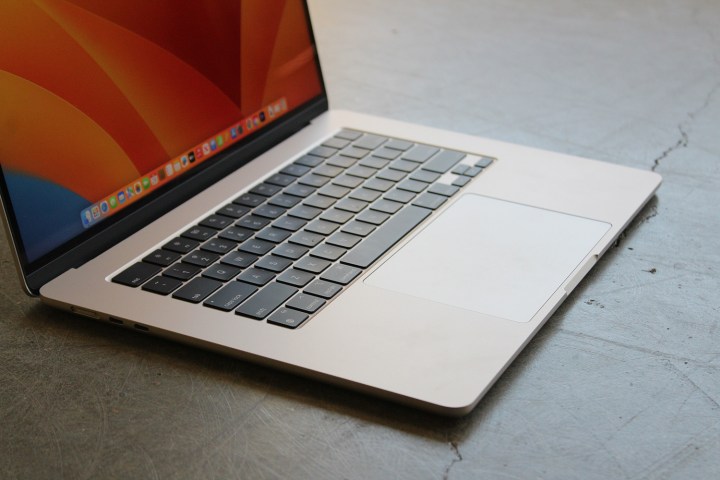
The MacBook Air 15-inch uses the same design as the 13-inch MacBook Air. It’s not dissimilar to the 14-inch MacBook Pro, but the design deviates in a few important ways. The most important difference is in size. An inch difference in screen size doesn’t sound like a lot, but the 15-inch MacBook Air also has slightly thicker bezels, adding even more to the overall footprint of the device. When you put these laptops side by side, the 15-inch MacBook Air takes up more space on the table. The width is the most dramatic dimension, giving you what feels like a lot more screen real estate to work with. That really is the primary selling point of the 15-inch MacBook Air, and should be the reason you’re choosing it.
Thickness and weight are the other main points of difference in terms of size. The MacBook Air 15-inch is just 0.45 inches compared to the 0.6 inches of the MacBook Pro 14-inch. The MacBook Air really is the thinnest 15-inch laptop you can buy right now — and it really does look sleek next to the MacBook Pro. The two laptops are closer in weight, though the MacBook Air is still lighter at 3.3 pounds compared to the 3.5 pounds of the MacBook Pro.
From a design perspective, the other differences include the keyboard, which doesn’t have the killer black backdrop like the MacBook Pro. It also doesn’t have the on-deck speaker grille cutouts.
Lastly, you also get some more color options with the MacBook Air, including Starlight, Midnight, Silver, and Space Grey. The MacBook Pro is limited to just Silver and Space Grey.
Ports
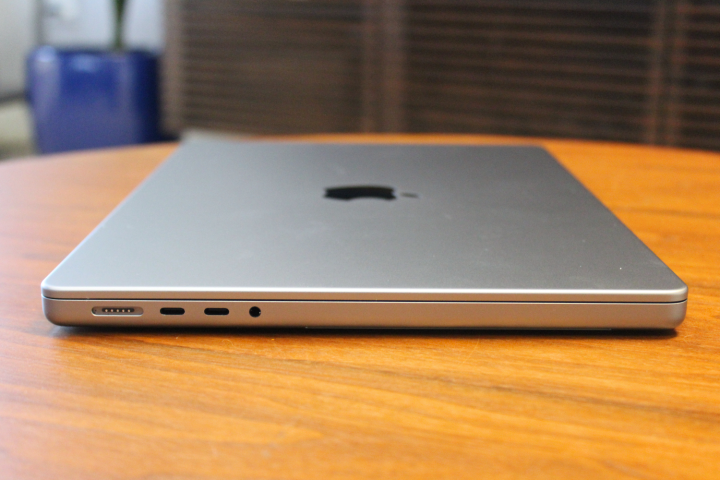
The MacBook Air 15 has less connectivity than the MacBook Pro 14, with just two Thunderbolt 4 ports and an audio jack (like the MacBook Air 13-inch). The Pro models come with three Thunderbolt 4 ports to go with an HDMI port and a full-size SD card reader. That makes the MacBook Pro 14 a lot more expandable. Both utilize MagSafe 3 chargers, though, saving a
Because the MacBook Air uses the base M2 CPU, it’s limited to just one external display with up to 6K resolution at 60Hz. The MacBook Pro 14 with the M2 Pro can handle two external displays, one at 6K/60Hz over Thunderbolt 4 ports and one 6K/60Hz combined with a 4K resolution at 144Hz if the HDMI port is used for the second display. The M2 Max model can handle up to four external displays, three at 6K/60Hz via
The MacBook Pro 14 is the laptop for you if you need more than just a single external display.
Performance
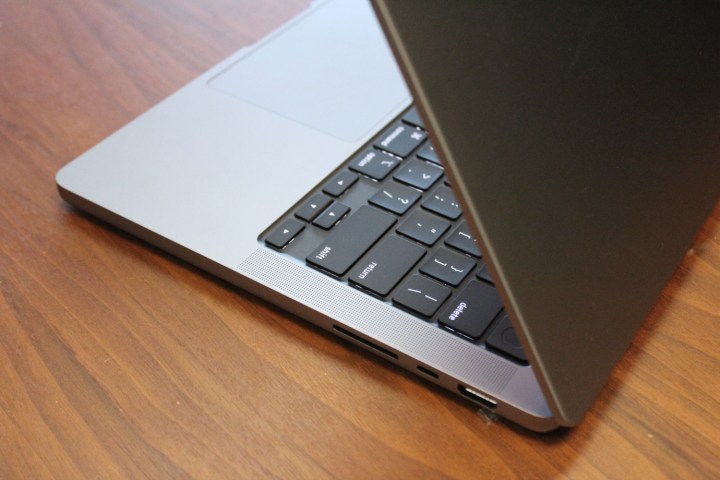
The 15-inch MacBook Air and 14-inch MacBook Pro are built on the same M2 chip, which is it performs very similar in the majority of tasks. Check out the single-core tests included below, where the two laptops hit very similar scores.
And yet, when it comes to applications that can benefit from additional CPU and GPU cores, there are some major differences in terms of performance because the MacBook Air is limited to just the standard M2, with 8 CPU cores and 10 GPU cores.
The 14-inch MacBook Pro, on the other hand, can be configured up to the M2 Max with 10 CPU cores and 38 GPU cores. As you can see below, that gives a huge boost to video encoding and exporting. It should be noted, however, that the scores you’re seeing are for the most powerful version of the 14-inch MacBook Pro. The $1,999 base configuration that comes with 18 GPU cores will give you much less to work with.
| Geekbench (single/multi) |
Handbrake (seconds) |
Cinebench R23 (single/multi) |
Pugetbench Premiere Pro |
|
| MacBook Air 15 M2 (M2 8/10) |
2606 / 10024 | 144 | 1596 / 8020 | 325 |
| MacBook Pro 14 M2 (M2 Max 10/38) |
2668 / 14422 | 85 | 1608 / 14789 | 467 |
Both laptops get incredible battery life. It’s amazing, but the extra performance of the 14-inch MacBook Pro doesn’t mean you have to give up battery life. According to our own testing, the two machines are right in line, providing up to 18 hours of battery life. Obviously, you’re more likely to run heavier applications on the MacBook Pro 14-inch, which will more quickly drain the battery.
But if you’re new to Apple Silicon MacBooks, you’ll be shocked by how long these laptops last.
Display and speakers
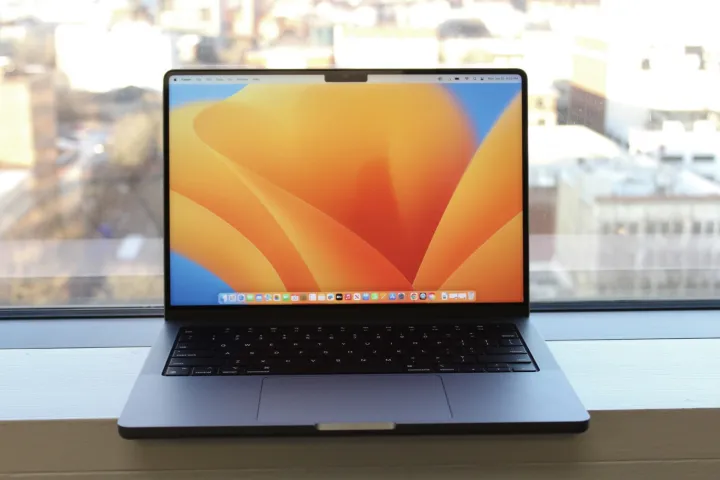
Another MacBook Pro 14 advantage is its 14.2-inch mini-LED Liquid Retina display running at 3024 x 1924 (254 PPI) resolution, which provides superior sharpness, brightness, color, and contrast compared to the standard IPS Liquid Retina display on the MacBook Air line. This includes the MacBook Air 15, which has a 15.3-inch IPS Liquid Retina display at 2880 x 1864 (228 PPI).
Both displays should offer similar colors, in terms of both gamut and accuracy. But the Mini-LED panel on the MacBook Pro 14 will get much brighter, especially for high dynamic range (HDR) content where it can approach 1,200 nits or more. It also has incredibly deep contrast providing inky blacks.
The MacBook Air 15’s display is also excellent, but the MacBook Pro 14 provides a truly premium experience, especially with the addition of the 120Hz dynamic refresh rate.
| MacBook Air 15 (IPS) |
MacBook Pro 14 (Mini-LED) |
|
| Brightness (nits) |
475 | 511 |
| AdobeRGB gamut | 100% | 100 |
| sRGB gamut | 90% | 89% |
| Accuracy (DeltaE, lower is better) |
1.23 | 1.13 |
| Contrast ratio | 1,200:1 | 35,450:1 |
Both laptops have six-speaker sound systems with force-canceling woofers. They support the same technologies as well, meaning that you’re likely to get the same excellent sound from both that’s among the best you can get in a modern laptop.
While the 15-inch MacBook Air is surprisingly competitive, the 14-inch MacBook Pro does offer more bass, providing a more robust sound profile. But really, both sound amazing.
Leave the MacBook Pro for the pros
With these two laptops, you can trust the branding distinction here. Leave the MacBook Pro for the creative professionals who depend on the extra performance to get their work done. Everyone else will be delighted by the experience of the 15-inch MacBook Air.
But if you’re leaving this entire comparison still unsure about what direction to head, let me offer one more bit of advice.
If you’re enticed about the extra performance of the 14-inch MacBook Pro but are bummed about the price, I’d recommend taking a look at prices for last-gen machines. There are refurbished versions floating around that are as cheap as the 15-inch MacBook Air but will provide far better performance. These laptops are identical in almost every way to the current-gen MacBook Pros, minus the small boost you get from M1 to M2.
Aside from that, I’d recommend getting to an Apple Store to see the two machines side by side. The difference in screen size and overall dimensions might help you get a better idea of which you’d be more comfortable with.
Editors' Recommendations
- This Windows laptop costs under $1,000 and handily beats the MacBook Air
- Apple may be working on a crazy modular MacBook with 3 screens
- Want an M3 Max MacBook Pro? There’s a lengthy wait ahead
- The M3 MacBook Pro may launch sooner than anyone expected
- Best Prime Day MacBook deals: Save on MacBook Air and MacBook Pro


